|
| |
Back to private
aircraft
|
|
Having built Jodel designes for many years,
the Centre Est Aviation company (CEA) changed their name to Avions
Pierre Robin, after their founder. They continued the evolutionary
development of the Jodel series which had led to the DR253 series.
Their first design under the new name was a further update of the
Jodel series under the designation DR400. This versatile type can be
fitted with various engines from 120 to 180hp, and has names to
match: Dauphin (120-140hp), Cevalier (160hp up to 1980), Major
(160hp after 1980), Regent (180hp) and Remorqueur (the dedicated
glider tug). The lower powered versions can seat two adults and two
children; the Regent can seat four full adults. The DR400 first flew
in June 1972. It was a great success. Over 1,350 have been built,
and the type remains in production. Cruising speed ranges from
120mph (Dauphin) to 140moh (Regent). with range from 500 to 850
miles. Gross weight ranges from 1,985 to 2,425lb. All versions are
22 feet 10 inches long, with a wing span of 28 feet 7 inches.
The top picture is a Dauphin at Turweston in July
2005. The middle
picture is a Regent at Le Touquet in Autumn 2005. Bottom: DR400
landing at Tatenhill in November 2007. |
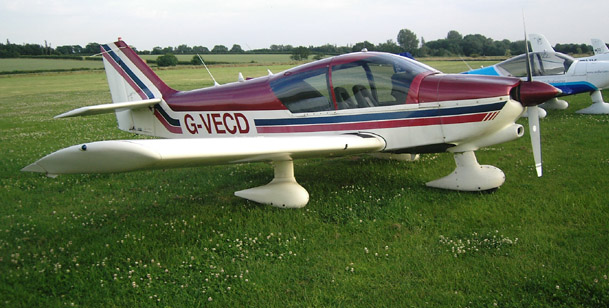 |
The Robin R1180 Aiglon was developed from
Robin's HR100, the first Robin design not to have bent wings, and
the first to be designed by Christophe Heintz. It is a four seat
tourer powered by a 180hp Lycoming O-360 engine. It first flew in
February 1977. It cruises at 150mph, has a gross weight of 2,530lb,
is 23 feet 7 inches long and has a wing span of 29 feet 6 inches.
This one was at Turweston in July 2005. |
 |
The Robin R2100 Alpha is also a Chris Heintz
design, this on being a two seat all metal light aerobatic aircraft.
There are various models in the series, varying by engine power
(from 108 to 160hp). Typical gross weight is 1,760lb, cruising speed
140mph and range 470 miles. It first flew in January 1976 and is
still in production. Over 130 have been built so far. It is 23 feet
4 inches long, with wing span of 27 feet 4 inches.
This one was at Elstree in October 1982. |
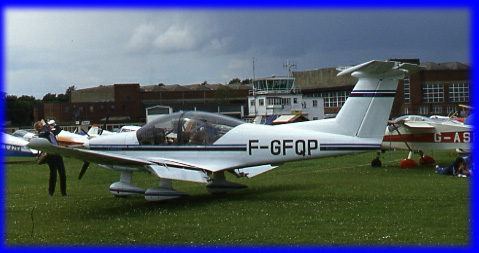 |
The Robin 3000 was intended as the
replacement for the DR400, but such was the appeal of the older type
that both have remained in production. The 3000, which first flew in
December 1980, has the T tail which was fashionable at the time. It
can seat 2 to 4 people depending on engine power, the choice ranging
from 118 to 180hp. Typical cruising speed is 140mph with a
range of 900 miles and gross weight of around 2,500lb. These figures
are pretty close to the DR400; it's obvious why the older design
continues to thrive. The 3000 is 24 feet 8 inches long, with a wing
span of 32 feet 2 inches. About 75 have been built up to February
2006. This one was at Cranfield in July
1988. |
 |
The Robin ATL was a one off ultralight
design, ATL standing for `Avion Tres Leger' (Very Light Aeroplane).
An interesting feature is the V tail, designed to reduce weight and
drag at the small cost of complexity and precision of control (the
best known V tail design is the famous Beech Bonanza). The ATL is in
a very different class though: it's a little fun runabout. A two
seater, it grosses only 990lb, and is powered by a 60hp JPX engine.
Still, its top speed is 120mph and it has a range of 500 miles. It
is 21 feet 9 inches long with a wing span of 33 feet 4 inches. 130
were built. This one was at Cranfield,
date uncertain. |
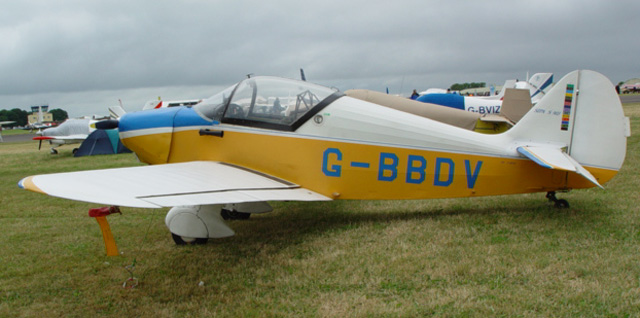 |
The SIPA 903 was a two seat trainer designed
for the Societe Industrielle Pour l'Aeronautique by Yves Gardan. It
first flew in June 1948. Not surprisingly it bears a passing
resemblance to Gardan's GY20 Minicab. The SIPA 901 (powered by a
75hp Minie engine) won a competition to design a French club
trainer, which resulted in 100 being built. The 903 is the same
aeroplane with a 90hp Continental engine. This gves it a cruising
speed of 110mph and range of 300 miles. Gross weight is 1,320lb. It
is 18 feet 9 inches long, with a wing span of 28 feet 5 inches.
This one was also at Cranfield, date uncertain. |
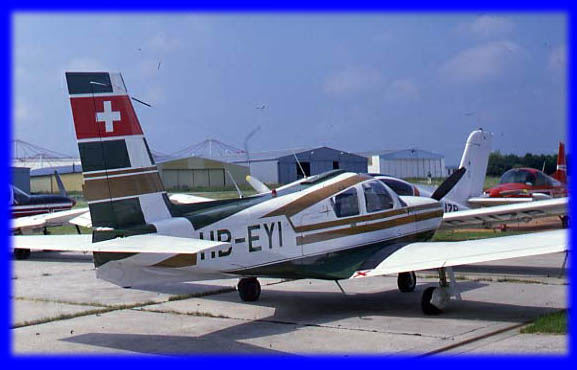 |
SOCATA (Societe de Construction d'Avions de
Tourisme et d'Affaires) was set up by Sud Aviation in the early
1960s as its general aviation division, and has retained its name
through the absorption of Sud by the giant Aerospatiale. It
originally produced the Morane-Saulnier Rallye and the Gardan
Horizon. In November 1967, a modified luxury development of the
Horizon was flown, known as the ST10 Diplomate. A four seater, it
was powered by a 200hp Lycoming IO-360 engine, which gave it a
cruising speed of 150mph and range of 800 miles. Gross weight is
2,690lb; length, 22 feet 10 inches; wing span, 31 feet 10 inches. It
is instantly recognisable by its very tall upright tail.
This Swiss Diplomate was at Toussus le
Noble in June 1979. |
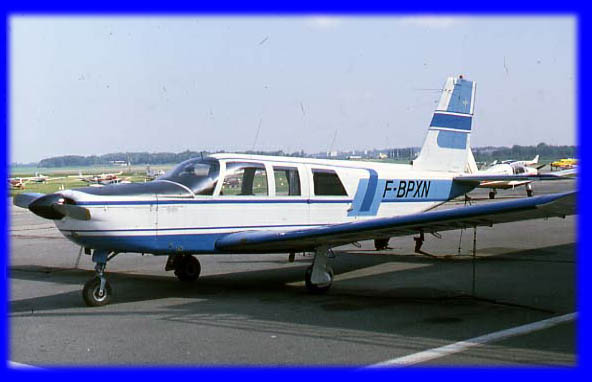 |
The SOCATA ST60 (unofficially known as the
Rallye 7) was intended as a 7 seat competitor to the Piper Cherokee
Six. Its 300hp engine gave it a top speed of 150mph and range of 800
miles. It conferred no advantages over the established American
competitor, and suffered from stability problems. It first flew in
January 1969. Development was abandoned after only one (this one)
had flown. It grossed 4,100lb, was 28 feet 10 inches long, and had a
wing span of 41 feet 3 inches. It was
pictured at Toussus in June 1979. |
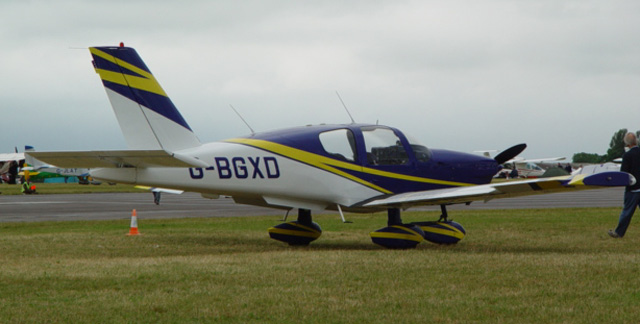 |
The SOCATA TB10 Tobago is essentially the
successor to the successful Rallye series. A highly capable four
seat tourer, it is powered by a 180hp Lycoming O-360 engine, giving
it a cruising speed of 125mph and range of 600 miles. It first flew
in February 1977, since when over 725 have been built (it is still
in production in 2005). Gross weight is about 2,500lb; length, 25
feet 3 inches; wing span 32 feet. The TB9 Tampico is similar but
powered by a 160hp engine and marketed as a trainer; 470 of those
have been built to date. This TB10 was
at Kemble in July 2005. |
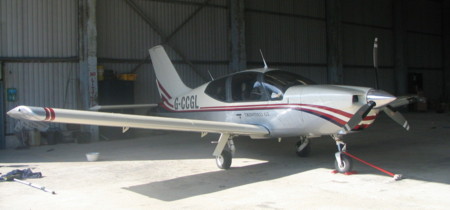 |
The SOCATA TB20 Trinidad is essentially a
retractable undercarriage version of the TB10, powered by a 250hp
Lycoming IO-540. This gives it a meaty 170mph cruising speed and a
range of 1,100 miles. Gross weight is up at 3,085lb; dimensions are
identical to the TB10. it is still in production; 68- had been made
by the end of 2005. |
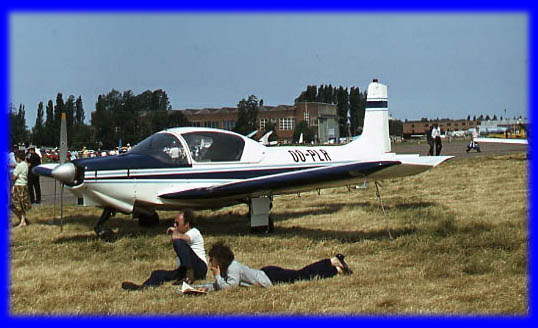 |
The Wassmer company was founded in 1905 by
Benjamin Wassmer, but it took until June 1959 for its first
proprietary powered aeroplane, the Wassmer WA40, to fly (they had
previously built lots of gliders, and Jodel aircraft under license).
The WA40 is also known as the Super IV or Sancy. It is a four seat
tourer powered by a 180hp Lycoming O-360 engine, giving it a top
speed of 160mph and range of 700 miles. Gross weight is 2,640lb;
length, 24 feet 8 inches; wing span, 32 feet 6 inches.
This one was at Cranfield in July 1983. |
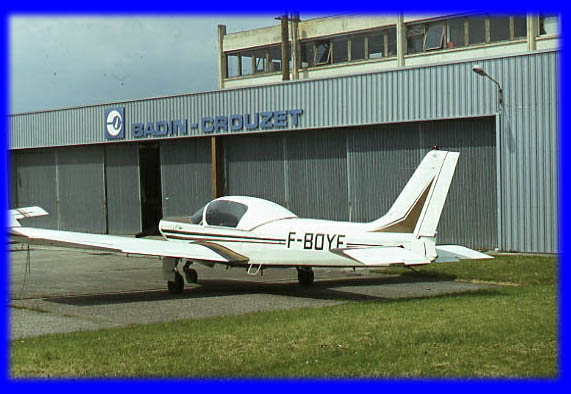 |
The Wassmer WA41 Baladou was basically a
simplified version of the Sancy with fixed undercarriage. It first
flew in March 1965. Weights, speeds and dimensions are the same as
for the earlier model. Apart from the undercarriage, the obvious
distinction (the swept fin) is actually also shared by later WA40s.
This is actually a WA40A, but is visually very
similar to the WA41. It was at Toussus in May 1983. |
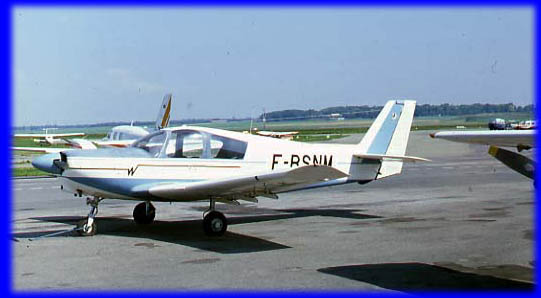 |
Wassmer's experience of light weight glider
construction led in March 1966 to the first flight of the world's
first all plastic production aircraft, the WA50. In 1969, an updated
version of this, the WA51 Pacific, was introduced. Powered by a
150hp Lycoming engine, it has a cruising speed of 140mph and range
of 600 miles. It is a four seater, with gross weight of 2,240lb,
length of 24 feet and wing span of 30 feet 6 inches.
This one was at Toussus in June 1979. |
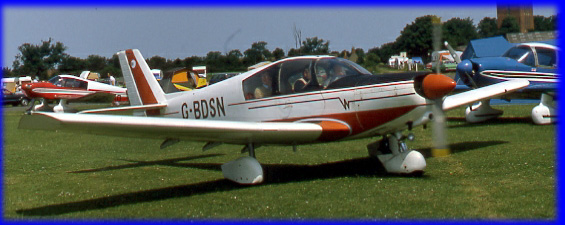 |
The Wassmer WA54 Atlantic, introduced in
1970, was a 180hp upgrade of the WA51. It is very similar to its
predecessor except for the higher gross weight (2,485lb), cruising
speed (155mph) and range (940 miles), all conferred by the bigger
engine. This one was at Cranfield in
July 1983. |





|